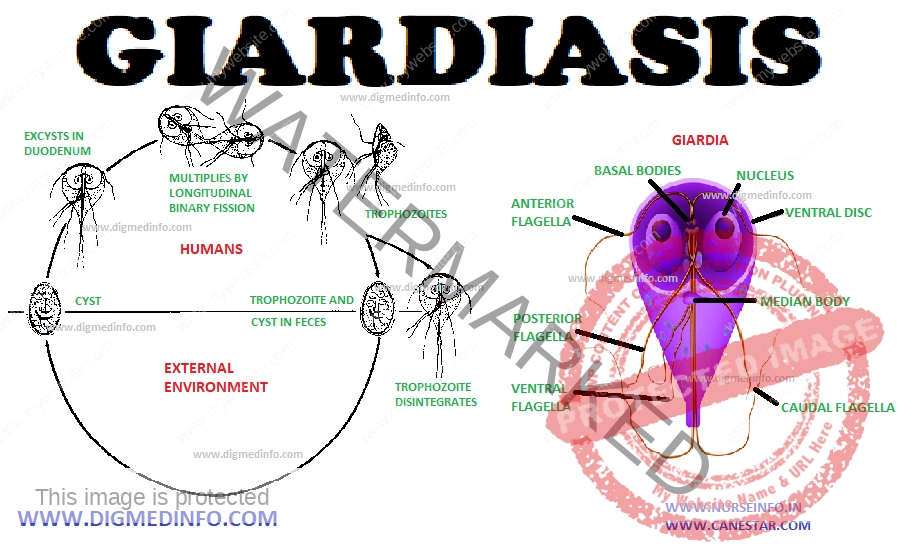GIARDIASIS – General Characteristics, Transmission, Pathogenesis, Clinical Features, Diagnosis and Treatment
General Characteristics
Giardiasis is infection of the small intestine by the flagellate protozoon—Giardia intestinalis (G. lamblia). In the tropics and subtropics, this parasite is very widely prevalent, particularly in children.
Giardia lamblia is a flat pear-shaped organism 12-18μ in diameter with eight flagella, two nuclei and a large ventral sucker placed anteriorly. These flagellates are found in large numbers in the duodenum and jejunum in between the villi, and attached to them by their suckers.
Occasionally biopsy specimens may show giardia between villi. With the aid of the flagella, giardia moves actively and this helps to identify the organisms in freshstools or duodenal aspirates. Cysts are formed which are passed in feces.
Transmission
Transmission occurs by ingesting the cysts along with food and water. Infection rates are high in closed communities. New immigrants and travellers may get the infection from endemic areas. Hypochlorhydria and hypogammaglobulinemia predispose to heavy infection.
Pathogenesis
Though the exact mechanism is not known, it is possible that a large number of flagellates adhering to the mucosal surface may reduce the area for absorption. In addition, irritation of the brush border of the villi, alteration in bacterial flora in the small intestine; and invasion of the submucosa have been suggested as contributing factors. Many cases show increased intestinal motility.
Clinical Features
Presenting symptoms range from mild abdominal discomfort to explosive diarrhea. Some infections may be asymptomatic but the majority is subacute or chronic. Nonspecific symptoms include failure to thrive, abdominal pain, epigastric distress, intermittent diarrhea and general ill-health. Features of malabsorption may occur, especially in children and this should suggest the possibility of giardiasis.
In some outbreaks explosive diarrhea with watery foul smelling stool may be the presenting symptom. Giardiasis is a frequent cause for traveller’s diarrhea in endemic regions. The acute attack lasts for 3-4 days but in children the course may be prolonged for weeks or months and it results in malabsorption state. Many cases go into spontaneous remission and carrier state develops in them.
Diagnosis
Giardiasis is a common cause of diarrhea in children and vague abdominal discomfort in adults. Fresh feces should be examined for identifying the motile flagellate. Presence of the active flagellate in fresh stool or in the duodenal aspirate confirms the diagnosis. In many cases mixed infection with Giardia and other intestinal pathogens like
E. histolytica or helminths is common. Clinical severity does not always correlate with the number of parasites seen in feces. In mild infections, repeated examination and concentration methods (formol-ether concentration method or Zinc sulphate floatation) may be required to
establish the diagnosis. In some cases, when feces do not show the parasites, duodenal aspiration has to be done for recovering them. Presence of cysts indicates the carrier state. These can be identified by examining iodine-stained preparations of feces.
Treatment
The drug of choice is metronidazole in a dose of 15 mg/kg/day given for seven days. In 80-90% of cases the infection is eliminated. In resistant cases this course can be repeated. Single administration of metronidazole in a dose of 30 mg/kg repeated after a week is also effective and it may be more suited for mass treatment on account of better patient compliance. Chloroquine 250 mg thrice a day for 5 days and tinidazole are also effective. Giardiasis can be prevented by improving food hygiene and environmental sanitation. Heavy chlorination of water supply is required for killing giardia cysts.


